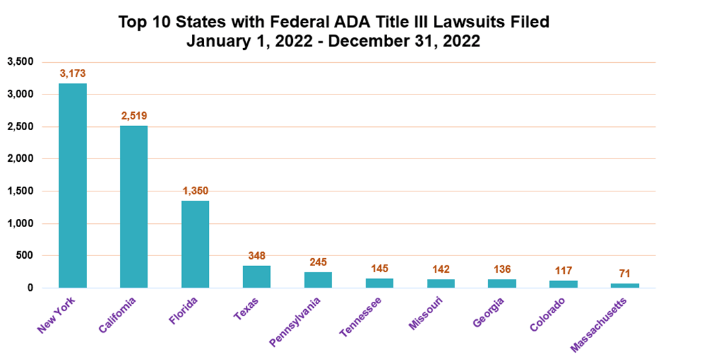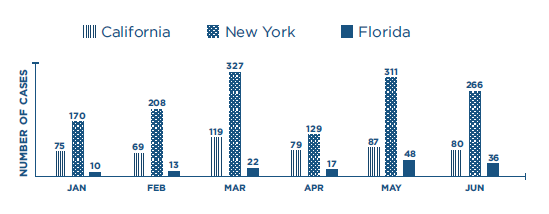ADA lawsuits has undergone significant developments, leading to key trends and crucial takeaways for businesses and individuals alike. With respect to the Americans with Disabilities Act, have played a vital role in promoting accessibility and inclusivity.
They have emerged as a powerful tool in ensuring compliance with accessibility standards. Additionally, holding businesses accountable for providing equal access to individuals with disabilities.
Furthermore, the surge in ADA lawsuits in recent years reflects an increased awareness of disability rights. Consequently a growing demand for accessibility in public accommodations, websites, and digital platforms. These lawsuits cover a wide range of issues, including physical barriers, discriminatory practices, and inadequate website accessibility. As a result, emphasizing the need for businesses to prioritize accessibility to avoid potential legal action.
Naturally, to analyze the key trends and takeaways provides valuable insights into the evolving legal requirements. Then serves as a guide for businesses seeking to enhance accessibility and mitigate legal risks. The following sections explore the trends in ADA lawsuits over the past five years. And offer actionable insights for businesses and individuals navigating the realm of accessibility and disability rights.
The Americans with Disabilities Act
The Americans with Disabilities Act (ADA) is a landmark civil rights law that prohibits discrimination against individuals with disabilities.
Furthermore, the ADA aims to ensure equal access to employment, public accommodations, transportation, and government services for people with disabilities. It requires businesses, employers, and public entities to make reasonable accommodations. Indeed to facilitate accessibility and provide equal participation for individuals with disabilities. The ADA has had a profound impact on improving the lives of millions of Americans. Moreover, promoting inclusivity, and fostering a more accessible society.
Understanding ADA Lawsuits
Over the past five years, the frequency of ADA lawsuits is increasing, particularly between the years 2018 and 2022. They have become more prevalent as individuals and disability advocacy groups seek to enforce compliance with accessibility standards. The surge in ADA lawsuits during this period can be attributed to several factors. They are greater awareness of disability rights, advancements in technology, and a growing emphasis on digital accessibility.
Initially, from 2018 to 2022, ADA lawsuits saw a substantial rise across various sectors. Notable increases in litigation involving website accessibility and digital platforms. Subsequently, as technology becomes integral, accessibility of websites and digital content has become a critical concern for individuals with disabilities.
ADA lawsuits related to website accessibility surge plaintiffs assert their right to equal access to information, goods, and services online. This trend reflects the growing recognition of the accessible internet to everyone, irrespective of disabilities. Businesses and organizations that fail to prioritize digital accessibility risk being targeted by lawsuits. This can lead to legal disputes, reputational damage, and financial consequences.
ADA Lawsuits are on Track for a Record
In 2022, Plaintiffs filed 8,694 Title III lawsuits in federal courts, a drop of 2,758 cases, or 24.1%, from 2021. It marks an astounding 319% increase from 2013.

Figure 1. Total Number of Title III Federal Lawsuits Filed Each Year January 1, 2013 – December 31, 2022
Increase in ADA Lawsuits filed in States
The other big news is that California – the historical leader in ADA Title III litigation – has fallen behind New York. Plaintiffs filed 3,173 cases in the Empire State compared with 2,519 in the Golden State. Third on the list was Florida with 1,350. Rounding out the top five (well behind the leaders) were Texas with 348 and Pennsylvania with 245 lawsuits. Sixth through tenth places went to: Tennessee (145), Missouri (142), Georgia (136), Colorado (117) and Massachusetts (71). (Missouri is a newcomer to the top ten.) Nevada and Illinois dropped out of the top 10. Illinois came in at number 11 with 63 cases and Nevada plummeted to 4 cases from 130 in 2021.

Figure 2: Top 10 States with Title III Lawsuits Filed January 1, 2022 – December 31, 2022
Recent downshift in ADA lawsuit filings
So what’s behind this decrease in filings? One prolific plaintiff’s firm in Southern California was sued by the Los Angeles and San Francisco District Attorneys. That lawsuit was dismissed by the trial court so that firm may return to its normal pace of filings. Several attorneys from that firm have left to form their own firm which will likely result in additional filings.
We should note that federal website accessibility lawsuits accounted for 37% of lawsuits filed in federal court in 2022. Not surprising because serial plaintiffs can visit websites for the purpose of filing a lawsuit without even leaving their house. Lawsuits involving physical barriers typically require a visit to the place of business.
The number of lawsuits filed in the last 5 years is 16,000 which is a significant number. Also these stats do not have the number of demand letters sent by plaintive law firms and other off-court settlements.

Figure 3: Cases between 2018 to 2022
The DOJ Effect in 2022
The DOJ restated guidance in March 2022 but failed to give businesses clarity. The guidance seems to have encouraged plaintiffs rather than offered hope of relief for businesses.

Figure 4: Lawsuits in three States – California, New York, and Florida
Lawsuits in Florida surged after the DOJ issued its March guidance. Growing from only 45 cases in the first quarter to more than 100 in the second quarter of 2022.
Leading Industry Sector in ADA Lawsuits
If you are in e-commerce or food service, your chances of receiving an ADA lawsuit increase substantially over other industries. In 2022, healthcare has moved into the top 3, up from #5 in 2021.

Figure 5: ADA Lawsuits surge in Ecommerce sector

Figure 7: ADA lawsuits against big Ecommerce brands in the spotlight
Widgets offer no Protection against ADA Lawsuits
Businesses using accessibility widgets received more than 300 lawsuits, a big year-on-year increase. In 2021, we reviewed 400 cases for the entire year. These lawsuits list the widget features as a barrier to equal access. In addition to WCAG violations and other user web barriers.

Figure 8: ADA Lawsuits filed against businesses using accessibility widgets
WCAG conformance helps protect brands from ADA Lawsuits
Naturally brands can protect from ADA lawsuits by conforming to the Web Content Accessibility Guidelines (WCAG). WCAG is a set of internationally recognized standards for creating accessible websites and digital content. By adhering to WCAG conformance, brands can significantly reduce their vulnerability to lawsuits and safeguard their reputation.
ADA website-related lawsuits are increasing in recent years, with businesses across industries facing legal action for non-compliance. By aligning with WCAG guidelines, brands can demonstrate a proactive commitment to accessibility, mitigating the risk of litigation.
Simple steps to avoid ADA Lawsuits
WCAG conformance involves implementing practices such as providing alternative text for images and ensuring keyboard accessibility. Brands must use clear and consistent navigation, and optimizing content for screen readers. By adopting these measures, brands can create a user-friendly and inclusive online experience.
Furthermore, WCAG conformance not only helps protect brands from ADA lawsuits but also enhances brand reputation and customer trust. By prioritizing accessibility, brands send a powerful message that they value diversity, inclusion, and equal access.
Brands can also foster a positive brand image, attract a wider audience, and cultivate customer loyalty. Moreover, by avoiding legal battles and negative publicity, brands can maintain their focus on growth and innovation.
Conclusion
The past five years have seen a surge in ADA lawsuits, highlighting the importance of accessibility and compliance with ADA.
ADA lawsuits are crucial to advocate for the rights of individuals with disabilities and promoting inclusivity across various domains.
The increase in ADA lawsuits for website accessibility and digital platforms, reflects the evolving legal landscape. It emphasizes the need for businesses to prioritize accessibility to mitigate the risk of litigation. Adhering to WCAG guidelines and implementing proactive accessibility can not only protect brands from ADA lawsuits but also enhance their reputation and customer trust.
Who we are?
codemantra is a leading Intelligent Document Processing (IDP) Solutions Provider. Its AI-driven platform automates digital document accessibility compliance. The platform captures, classifies, and extracts data, and transforms documents to the desired output format.
How codemantra helps?
codemantra’s accessibilityInsight remediates digital documents such as PDFs, PPT, Word, Excel, e Pub and makes them accessible and compliant as per ADA, Section 508, Section 504, WCAG 2.1 Level AA standards.
We provide everything from self-help tools, audits, remediation, and implementation support to help you stay on top of accessibility challenges with a very cost-effective solution.
Contact us at 1 (800) 769-9715 or email us at engage@codemantra.com for more information on how to make your documents accessible and ADA complaint.








